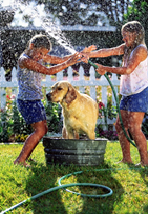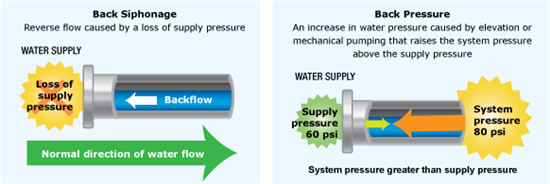The Joint Municipal Water and Sewer Commission is charged with the responsibility of protecting the water quality by identifying and eliminating all cross connections that could potentially contaminate the water distribution system. JMWSC requires all water service connections that present a potential hazard to install and maintain a backflow prevention assembly that meets our specifications.
What is a cross-connection
 A cross-connection is any temporary or permanent connection between the potable (i.e., drinking) water system and another source containing non-potable water or other substances that could contaminate your drinking water if a backflow condition occurs. An example of a temporary connection could be a garden hose attached to a sink or a spigot with the end of the hose submerged in a tub full of detergent. An example of a permanent connection could be the water supply line to the boiler of a hot water heating system.
A cross-connection is any temporary or permanent connection between the potable (i.e., drinking) water system and another source containing non-potable water or other substances that could contaminate your drinking water if a backflow condition occurs. An example of a temporary connection could be a garden hose attached to a sink or a spigot with the end of the hose submerged in a tub full of detergent. An example of a permanent connection could be the water supply line to the boiler of a hot water heating system.
What is backflow?
Backflow is just what it sounds like: water flowing in the opposite direction from its normal flow. With the direction of flow reversed (due to changes in pressure), backflow can allow contaminates to enter the potable water system through cross-connections. Without proper backflow devices, something as useful as your garden hose has the potential to contaminate your home’s water supply and the public water system.
A potentially hazardous cross-connection occurs every time someone uses a garden hose sprayer to apply fertilizer or herbicides to their lawn. Without a backflow prevention device between your hose and the spigot, the contents of the hose and anything it is connected to, can backflow into the home’s water system and contaminate your drinking water.
How can a backflow occur?
Backflow can occur two different ways, by back-pressure or back-siphonage.

What is back-siphonage?
Back-siphonage occurs when there is a sudden reduction in the water pressure in the distribution system, such as if a water main breaks or if the fire department uses a large amount of water to fight a fire, water flow can be reversed. This can create a suction effect, drawing contaminates into the drinking water system.
What is back-pressure?
Back-pressure is when a pump, elevated tank, boiler, etc. in a private system creates pressure that is greater than the pressure provided by the City water system. This can reverse the direction of flow, pushing contaminates into the drinking water system.
How can I prevent a cross-connection?
There are a few ways you can prevent a cross-connection:
- Never place the end of a hose where it can suck contaminates into your home’s water system. For example, do not leave the end of the hose submerged in the swimming pool or a tank when filling. Always maintain at least a one inch gap between the end of the hose and the pool, tank or other source of potential contamination.
- Use proper backflow protection devices. Each spigot at your home should have a hose-bibb vacuum breaker installed. This is a simple and inexpensive device that can be purchased at any hardware store and screwed directly onto each spigot (as easy as attaching your garden hose).
- Underground irrigation systems are one of the types of cross connections posing a health hazard to the public drinking water system. Contamination from herbicides , pesticides and animal dropping can enter your irrigation system when below ground sprinkler heads are used.
.jpg)
- Installation of a Double Check Valve Prevention Assembly can prevent back pressure or a back siphonage condition. NOTE: Starting July 2004, JMWSC requires all new residential meters with or without irrigation be equipped with a double check valve assembly.
Why do water suppliers need to control cross-connections and protect their public water systems against backflow?
Backflow into the public water system can introduce contaminates, making the water in the system unusable or unsafe to drink. Every water supplier has a responsibility to provide water that is usable and safe to drink under all foreseeable circumstances. Furthermore, consumers generally have absolute faith that water delivered to them through a public water system is always safe to drink. For these reasons, each water supplier must take reasonable precautions to protect its public water system against backflow.